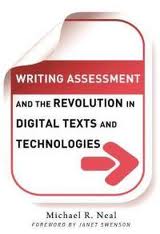Review Conversation
Chapter Five offers one of my favorite rhetorical outcomes of our academic conversations about technology in writing: new words! Neal placates my need for Frankenstine-esque constructions with his "hyperactive hypertechs" creation. He begins with the OED and ends up with his own take on integrating the prefix "hyper" into plays on digital texts. He explains that hyperactive describes writing exigencies, and hypertechs are multimodal, interactive texts that are also importantly, connected to rhetorical elements of digital writing and evaluation of that writing within its new rhetorical situations. Neal's primary argument here is that a bi-directional, informing relationship must exist between digital exigencies and the process of assessing texts developed through them. He gives us a two-fold example of how a common object of assessment still troubles instructors – the portfolio/e-portfolio conundrum.
Neal begins his argument with a brief history of portfolios as objects of evaluation in first-year writing courses. He then offers two narratives of his experiences with e-portfolios. Neal is bothered by an idea put forth by some institutions of higher learning, that e-portfolios are the end-all/be-all of assessment opportunities. Wondering aloud, he postulates about necessary resources for positive outcomes, particularly those connected to students' rhetorical growth. Neal crystallizes the argument once again in a visual. He lists questions that he asserts must be addressed if we are to interrogate the e-portfolio itself as a tool of assessment. He asks WHO will design and assign the instrument; WHO will determine criteria for assessment of it; WHO reads it for purposes of assessment; WHAT feedback is provided for students; WHAT happens if students fail the assessment; and WHAT space exists in this instrument for students to reflect on their writing. I agree with Neal that if an institution cannot answer the above questions with a focus on student learning, then it uses the instrument simply as a means of administrative assessment. In my own experience as an English graduate teaching assistant, I have witnessed that some Universities seems more interested in the "hoops" of instruments that instructors and administrators should jump through, as opposed to "paths" we walk with students to facilitate their rhetorical growth. And, while I acknowledge my own naïveté as an emerging participant in conversations like these, I find that I must give a voice of support to what Neal describes as e-writing assessments that are "locally-owned and operated" (p. 85) that mark formative evaluations for growth, as opposed to large-scale, summative, institutional assessments designed primarily to re-enforce archaic binaries not only between instructors and students but also between those instructors (many of which are graduate students) and their administrative superiors. But I digress…
Neal presents his "locally-owned" e-portfolios as examples of how we can assess student writing formatively, giving instructors relevant snapshots of rhetorical growth and giving students opportunities for that growth as well as reflection and connectivity towards their writing experiences. Neal wraps up Chapter Five with a synthesis of the three 21st-century writing characteristics he argues are vital to navigating digital writing spaces: (1) hypertexts; (2) hypermedia and (3) hyperattention. These three elements are linguistic creations designed to pinpoint the significance of each in regards to why, how and who assesses student writing.
